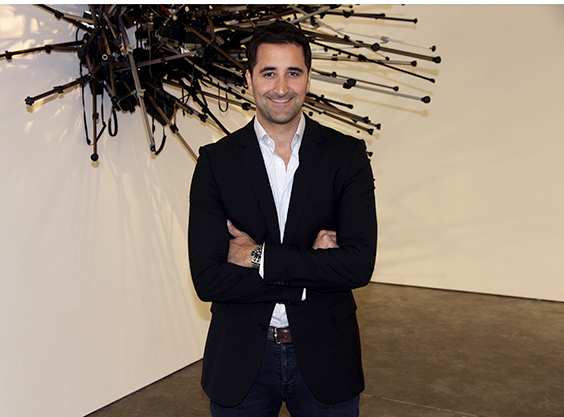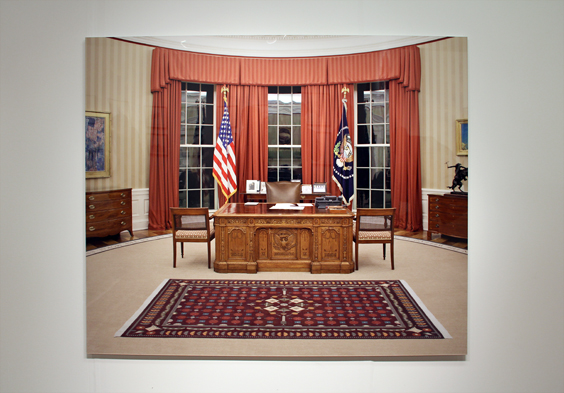
Antoine Ertaskiran. Courtesy galerie antoine ertaskiran, Montréal
galerie antoine ertaskiran is quickly rising as one of the newest yet most active contemporary art venues in Montréal. Since its official inauguration in September 2012, Ertaskiran has already accumulated a total of seven exhibitions within its main space, alongside a hat trick of art fairs (Toronto 2012, VOLTA NY 2013 and Montréal’s Papier 13). Acknowledging a deep-rooted experience in the art business, director Antoine Ertaskiran discloses to M-KOS a few of his latest ambitions for this new space in the heart of Griffintown.
MKOS: How did you initially start up this gallery project?
Antoine Ertaskiran [AE]: I had the idea to launch my own gallery two years ago. By then, I had already been in the business for 15 years. My father had a gallery in Paris (Galerie Nikolenko) so I grew up in the business, grew up going to museums and art galleries. I was born here [in Montréal] but my family moved to Paris when I was 8 months old, and we stayed there until I was fifteen. Then after high school, I went to University of Montréal to study Art history and started working with my father even before I finished my degree. We had a family-run gallery on Sherbrooke Street (Galerie Berensen) and for about past six or seven years I was dealing mostly in the secondary market, modern and contemporary international art. Two years ago, I felt the need to change the model of my business, to either move abroad or stay in Montréal and open the gallery. I decided for the latter because I love the city, I love the art scene here and also my family lives here.
MKOS: By looking at your website, already we can find some activities programmed from May of last year, is that when you started?
AE: It officially opened in September 2012, although I’ve had this space and rented it since August 2011. In the meantime, my wife and I had a son so that made things things took a bit longer then expected. I could have opened in the Spring of 2012, and in fact we did organise a few shows before the official opening in September but I decided to wait a few more months, to open properly with a roster of artists and more exhibitions planned.
MKOS: So officially the gallery was in operation for less than one year. But you seem already very active outside the space as well, in terms of participating at art fairs, for example. Is this part of your bigger plan?
AE: Definitely. Especially for the Montréal art market, it is such a small market, I think it is important for galleries to be at art fairs, specially the strong international fairs. Of course getting in is not necessarily easy, but we’re starting with the smaller fairs, the parallel satellite fairs. Art fairs give collectors, and other people in the [art] business, and the general public, a snapshot of contemporary art across the world. To be part of that I think is very important.

Dominique Blain, In the Oval Office, 2012 at galerie antoine ertaskiran’s booth in VOLTA NY, 2013. Photo by M-KOS
MKOS: You also took a risk in showing political art with Dominique Blain, at the Volta fair in New York, which critiqued American war policies. What was the reaction, would you do it again?
AE: It was a risk but a calculated one. Dominique Blain’s work is always powerful but her message is universal. Placing a rug made of landmines inside the Oval Office did offend some people, but in general the response was very positive. We try to get a reaction out of people, isn’t that the point of art? To make you think, make you smile or frown…
MKOS: Is this also how you choose the artists on your roster?
AE: My reflection starts with the art I really love, that I really want to work with, you fall in love with the [production of] an artist. Obviously once you have a certain number of artists you try for them not compete with each other. It’s kind of hard to juggle that. As a contemporary art gallery, I think it is important to represent different types of work, cross-disciplinary work. But falling in love with the work of the artist always comes first, and if I don’t, it is much harder to work with.
MKOS: What about the production flow of exhibitions, do you usually work with specific curators or strictly with a core team?
AE: We haven’t worked with curators yet. So far we have only worked with our team at the gallery. But we started looking to associate with other galleries. We have a plan to show two of our artists in Toronto in July. We plan to do satellite shows in Montreal and also internationally.
MKOS: And the gallery’s location – Griffintown, unlike the cluster of art spaces in the Belgo building, in downtown Montréal, this is slightly more remote for many audiences. Was it a strategic move to open here?
AE: It was definitely a strategic decision, I was taking a chance in a new neighbourhood, like other galleries did before me. For example, Simon Blais was the first to open his gallery in the Mile End [in 1989], Parisian Laundry in St Henry. They took a chance but found great spaces. At first I thought about the Belgo and I looked into the available spaces there. The Belgo is a great place for many galleries and it has a creative atmosphere, but none of the spaces did it for me. I wanted a space directly accessible from the street and that could accommodate any kind of art, with high ceilings and a big garage door and so on, like the galleries you see in Chelsea, which definitely inspired me. Griffintown is an up and coming area, there is the Arsenal and other projects are gradually coming into this area now. In fact, it’s not too far from the center of the city. I found it attractive and signed a long-term lease so affordability is another important aspect of an up and coming neighborhood.

Michael A. Robinson, The Origin of Ideas, 2013. Installation view. Courtesy galerie antoine ertaskiran, Montréal
MKOS: Montréal is not so much an international art hub, but it is central as far as Canadian art is concerned. Did this influence your decision to stay in Montréal?
AE: For me it was a personal decision. If there were no real art scene in Montréal, I wouldn’t have stayed here. I believe in the creative quality of the artists we have here. Montréal is such a creative city for contemporary art, in my opinion, definitely the strongest in Canada. Even going back say 30 or 40 years ago, when other groups of artists from here were drawn to New York, for us it’s the same thing. We’re so close to this unbelievable hub of creativity which is New York. New York shines over us and raises the production and quality of the work in Montréal. You can open a gallery anywhere really, but to be a contemporary art gallery you need to show the artists in your community, to be able to show Montréal artists here in Montréal, across Québec and across Canada. For me, the gallery is based here and I’m happy to shed light on the local artists but my ultimate goal is to be international, bring all that talent abroad.
MKOS: Some think that in Canada, the art funding is counter productive to the art market. From your experience of doing fairs and travelling to art events internationally, do you think this is that really the case?
AE: The art funding here is very important. To be honest, the structure of Québec for me, was something new which I learnt over the past couple of years. Although for private galleries, you have to be in the business for a certain number of years before some funding is available but I think the support at the different levels of government [municipal, provincial and federal] and the different groups working with artists are imperative, and impact the work 1000%. The money artists get from not selling their work but from someone believing in it, that funding support definitely shows up in the work. When you talk about the quality of art in Montréal, a small market compared to Toronto or Vancouver, to be able to create on that level quality work definitely depends on the money and support the artists receive [from the arts funding].
MKOS: And the most challenging hurtle for galleries aiming to become international, is it mostly about financial logistics?
AE: As I said, my first thought is that I don’t want to be only a Montréal gallery, 100% sure [laugh]. Of course costs are high and like any serious business, you need a business plan and a long-term vision, but I didn’t want to wait three, four, five years to be in an art fair. I want to go to fairs right away, to be able to grow the business, grow a customer base, and export my artists. Like many new businesses you have to be ready to loose money in the first two years. It’s imperative. But if you strategically place yourself among the best galleries in the relevant art fairs, your business will grow faster. So far so good…
MKOS: Where do you want to be when the gallery grows up?
AE: You want to be among the best in the business, be relevant, to be mentioned in the art circles that we are producing good artists and good exhibitions, [if that happens] then I would be happy.
For the last six months, I believe that I’ve been doing things right. If I’m able to push local artists onto broader audiences, to inspire people then I am very happy. I also believe that part of our job as gallerists is to educate people. The more people we influence, the better. Also, eventually, bringing international artists here as well would help put us on the map even more, I mean, Montréal, and Canada. The Venice Biennale is starting soon and almost half a million people will attend the biennale and probably see Shary Boyle represent Canada among many other artists known across the world, and that’s got to count. That’s where I want the gallery to be… â–
Interviewed by Oli Sorenson

Michael A. Robinson, Radar range, 2013. Reinforced hydrostone, varnish. Courtesy galerie antoine ertaskiran, Montréal
Current exhibition
Michael A. Robinson: The Origin of Ideas
through 8 June 2013
galerie antoine ertaskiran
1892 rue Payette
Montréal, QC H3J 1P3
Canada
galerieantoineertaskiran.com
Opening hours
Tuesday – Saturday: 10h00 – 17h00
and by appointment

Michael A. Robinson, Panoptic illumination, 2013. Lamps, electric power cords, tripods. Courtesy galerie antoine ertaskiran, Montréal
